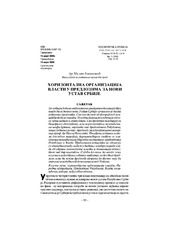Приказ основних података о документу
Horizontal organization of power according to the proposals for a new Constitution of Serbia
Horizontalna organizacija vlasti u predlozima za novi Ustav Srbije
| dc.creator | Jovanović, Milan N. | |
| dc.date.accessioned | 2021-04-02T11:45:22Z | |
| dc.date.available | 2021-04-02T11:45:22Z | |
| dc.date.issued | 2005 | |
| dc.identifier.issn | 1451-4281 | |
| dc.identifier.uri | http://rfpn.fpn.bg.ac.rs/handle/123456789/103 | |
| dc.description.abstract | During four years of intensive discussions and attempts of three governments to adopt a new Constitution of Serbia, ten constitutional projects have been accomplished. They all share the same agenda of theoretical concept of the power sharing. Special attention is paid to the relations between legislative and executive aspects of it. All projects call for bicefal executive power with various competencies of the head of the state included, in most of the cases in the role of the President of Republic except in the case of the proposition for establishment of the monarchy by Prof Dr. Pavle Nikolic. The proposed constitutional models thoroughly subsume the parliamentary system with classic warranties for the National Parliament, the president of Republic and the government. The proposed concepts are not very inventive when it comes to the control of the government's activity and domination of the executive regulation over the Parliament. According to these, in many regards, the key aspects of the content of the Constitution, there is no any controversial constitution proposal which could endanger the adoption of the new Constitution. | en |
| dc.description.abstract | Za četiri godine intenzivnih rasprava i pokušaja tri vlade da se donese novi Ustav Srbije sačinjeno je deset ustavnih projekata. Svi oni polaze od teorijskog koncepta podele vlasti. Posebna pažnja posvećena je odnosu legislative i egzekutive. Svi projekti plediraju za bicefalnu egzekutivu ali sa različitim ovlašćenjima šefa države, najčešće kao predsednika Republike, osim u jednom slučaju - predlogu za uspostavljanje monarhije prof. dr Pavla Nikolića. Ponuđeni ustavni modeli dosledno razrađuju parlamentarni sistem sa klasičnim ovlašćenjima Narodne skupštine predsednika Republike i Vlade. Predloženi koncepti ne odlikuju se inventivnošću kada je u pitanju kontrola rada vlade od strane zakonodavne vlasti i dominacija egzekutive nad parlamentom. Sudeći po ovim, po mnogo čemu ključnim aspektima ustavne materije, ne postoje predlozi koji bi pomogli predmet sporenja do tačke koja bi značila nemogućnost donošenja novog Ustava. | sr |
| dc.publisher | Institut za političke studije, Beograd | |
| dc.rights | openAccess | |
| dc.source | Politička revija | |
| dc.subject | horizontal organization of the power | en |
| dc.subject | National Parliament | en |
| dc.subject | President of the Republic | en |
| dc.subject | government | en |
| dc.subject | competencies | en |
| dc.subject | elections | en |
| dc.subject | inter-relationships | en |
| dc.subject | horizontalna organizacija vlasti | sr |
| dc.subject | Narodna skupština | sr |
| dc.subject | Predsednik Republike | sr |
| dc.subject | Vlada | sr |
| dc.subject | ovlašćenja | sr |
| dc.subject | izbori | sr |
| dc.subject | međusobni odnosi | sr |
| dc.title | Horizontal organization of power according to the proposals for a new Constitution of Serbia | en |
| dc.title | Horizontalna organizacija vlasti u predlozima za novi Ustav Srbije | sr |
| dc.type | article | |
| dc.rights.license | ARR | |
| dc.citation.epage | 42 | |
| dc.citation.issue | 1 | |
| dc.citation.other | 4(1): 11-42 | |
| dc.citation.spage | 11 | |
| dc.citation.volume | 4 | |
| dc.identifier.fulltext | http://rfpn.fpn.bg.ac.rs/bitstream/id/1/100.pdf | |
| dc.identifier.rcub | https://hdl.handle.net/21.15107/rcub_rfpn_103 | |
| dc.type.version | publishedVersion |

